#no one does it like shippuden's soundtrack moments
Text
our top jaw-dropping moments in naruto and shippuden
(no order and by far not complete because oh sweet jam there were so many moments)
Haku jumping in front of Zabuza
Itachi putting a genjutsu raven IN Naruto to trigger a genjutsu to break him out of the reincarnated posessed state
How about that entire fight with Sasuke and Naruto at the waterfall
Guy opening the Gate of Death
Lee dropping his leg weights
Kakashi using Kamui on Pain's needle
Ino possessing Obito for a solid five seconds GIRL
Madara walking onto the battle field and summoning yk, METEORITES
Pain decimating Konoha with Shinra Tensei (translated literally as “Heavenly Subjugation of the Omnipresent God” which is what this entire scene felt like in real time)
Madara putting the time warp justu on himself to revive himself FROM DEATH
Deidara blowing himself up tae shet
Minato teleporting above Obito and getting that solid rasengan hit on him
Literally every time Naruto goes into sage mode
Also the first time we saw 4 tails mode holy s h I t
Hidan and Kakazu's deaths
Hinata bodying Pain
Konan's death
Shikamaru breaking his own finger to break himself out of Teyuya’s genjutsu CLUTCH
Kakashi and Obito's final fight
Gaara shielding the sand village from Deidara's bomb
Rock lee and Kimimaro's fight ft. Drunken Fist
sand siblings showing the fuck up to help the sauske retrieval party
Danzo’s fight with Sasuke
Tsunade telling Madara of the four rules of medical ninja and then introducing him to her fist
Itachi putting Kabuto under his Izanami
Sakura showing the fuck up to slam Kaguya
First time Sasuke appeared on screen in shippuden
Sakura MANUALLY pumping Naruto’s heart to keep him alive oh my g-
#naruto shuppuden spoilers#heckken lots of spoilers but these moments were top tier#not complete by any means#naruto shuppuden#top moments list#we just really enjoyed the show okay#there will probably be more as we remember them and re-watch the show hah#feel free to add to the list though#no one does it like shippuden's soundtrack moments#no one does it like MIGHT GAI hot damn#i get too hyped looking at this list I gotta stop
136 notes
·
View notes
Text
FEATURE: The Best Naruto Shippuden Fight Doesn't Include Naruto
This article written by Jared Clemons was originally published on May 22, 2020
If you’ve ended up watching enough Naruto, you’ll begin to pick up on the overall style of the show. The way the characters look, how they animate, the specific colors used throughout the series, there’s a certain way that Naruto and Naruto Shippuden look through their combined first 300 episodes. On rare occasions, that style switches to help showcase a big fight, such as early on against Zabuza and Haku, Rock Lee vs. Gaara, and in Shippuden when the Leaf takes on Hidan and Kakuzu, Sasuke vs. Deidara, and others further in the series. This fluid animation style alters how the characters look and move, while also using more of a muted color scheme. Most notably, this is usually thanks in part to episodes that Hirofumi Suzuki worked on as the animation director.
One episode that Suzuki worked on that sticks out by subverting the regular formula of Naruto is Episode 82 of Shippuden, "Team Ten." It’s not an episode that features any big fights, nor are there really any big conflicts between characters here. Instead, we see the inner turmoil that Shikamaru is facing following the death of Asuma. He’s skipping out on his funeral and just seems lost after the previous mission went horribly wrong. So, instead of creating another episode of Shippuden that is the same formula as everything else, Suzuki and the rest of the production staff decided to go in a different direction — one that is more likely to be seen on the big screen, rather than in television.
Given the highly emotional aspects of where the story is, the episode does a lot to make you feel uncomfortable — to get you into the same headspace as Shikamaru — and at times almost makes the viewer seem like a voyeur. We’re essentially going through the same process as Shikamaru as we see him tell Kurenai about Asuma’s death, relay that to people in town, figure out his own emotions about what happened, and then come back from the brink and find a way to stand tall again.
In order to truly get into Shikamaru’s mindset for this episode, the pacing slows to a halt. Everything is laborious and with a certain purpose to it. This is the kind of pacing and style you’d most likely see from a Naruto film or a more serious drama series rather than what you’d expect from a shonen series. It would be hard to pull off what this episode wants to force the viewer to witness if it was the same package that every other episode of Naruto Shippuden is. In order to pull viewers in and let them immediately know that something is wrong, you’ve got to disrupt their normalcy and their perception of what the series is.
Throughout the episode, if you’re watching for the first time or just trying to pay attention to figure out what’s different, you’ll notice a few things. Most notable to me was the lack of camera movement. Shonen series and anything with action will rely on camera movement to make episodes have a fast pace to them. Instead, here we get only four shots that feature any sort of movement. Each one is incredibly slight as well. They’re not quick but are slow and subtle to where you can easily miss them. In fact, the first bit of camera movement doesn’t occur until nearly halfway through the episode, which seems striking for this series. Instead, we get a lot of cuts and shots that linger long enough that it begins to feel uncomfortable.
One of the more striking shots in this episode is when Shikamaru and his father, Shikaku, play shogi together. There are cuts between the two as they begin to play, but then the camera goes to a side angle of the two playing and going back and forth with their moves. You’d think that eventually there would be cuts to each character as they place their moves and with Shikaku trying to tell Shikamaru why he shouldn’t beat himself up over what happened. Instead, the shot lingers. For two whole minutes. That’s not something that occurs in most series that are relegated to 24 minutes of air time. After all, camera cuts help keep the pace up and give viewers something new to look at. Yet, it fits the overall tone and style of this episode. You start to see Shikamaru’s emotions begin to get the better of him from this shot alone, and it’s able to tell that story in a better way than it would have if it was just the camera cutting between Shikamaru and Shikaku.
That scene, and those two minutes spent looking at their shogi game, leads up to Shikamaru finally being able to break down. This brings up another strange aspect of this episode: This scene is the first time we hear any music in the episode and again, we’re nearly halfway through. Before, you’d hear a lot of natural sounds such as insects humming or the chatter of people in the streets as Shikamaru wanders through the town. Even with the addition of music for this brief instant, it’s again subtle and not overpowering. It’s another aspect of something that you could easily gloss over as it comes and goes very quickly. That might seem as if it doesn’t really fit the emotional nature of this scene given that Shikamaru begins to cry and wail in this room they were playing in, but it absolutely fits because the music is just giving the viewer the slight push to tell them this is emotional. That doesn’t need to overpower the scene when you’ve got a character letting out deep emotional pain at the same time.
Perhaps this is why Suzuki and the rest of the production staff were tapped for this episode. Their style of animation that has worked so well for some of the biggest fights in the series works its magic for truly showing the emotional pain a character is going through. You’re able to see the pain and trauma rise up through Shikamaru’s face and then break through the levy as he’s finally able to let out all of his emotions and cry. His face distorts in realistic ways that wouldn’t have been the same if it was in the traditional animation or style. It’s the same kind of realistic expression that you would also have if you were in his situation, which of course is what the episode is trying to make you do. Become emotional and cry alongside Shikamaru.
One of the biggest takeaways I had from this episode is how much Suzuki and the team’s style reminded me of Naoko Yamada’s way of directing. Yamada’s work on K-ON and specifically Liz and the Blue Bird are very similar to what we see in this episode. There’s a lot of lingering shots, little camera movement, and relying more on cuts to showcase what’s happening — and a soundtrack that isn’t overemphasizing what’s happening. You truly get to see what these characters go through, which is an aspect of directing that Yamada accentuates as she’s said she likes to “watch people” and “get into the minds of the characters.” Those are definitely part of what makes this episode of Naruto Shippuden work so well. You’re truly able to dive into Shikamaru and see what he’s going through, how he’s able to figure out what to do next, and then act upon it.
The rest of the episode sees how Shikamaru is able to find an answer that gives him the drive to go out and finish the original mission and avenge Asuma. The pacing is still slow and methodical, but by the time we reach the end and Team Ten announces their plans to head out on their next mission while Tsunade tries to stop them, we begin to move back into the regular style of Shippuden as the music begins to take hold in a way you’d normally expect. In a way, this episode is able to pump the brakes on the whole pacing of the show, but then softly begins to accelerate by the end that lets you ease back into what you’d expect from the series.
There’s truly no way you could do this kind of episode for a series as big as Naruto every week. Obviously, it’d take too long to maintain this kind of quality for 500 episodes, so you’d have an episode a month at best, but also the charm of these subversions to the series would wear off rather quickly. Instead, you’d have fast-paced, action-packed episodes that would serve as that. “Team Ten” is a special episode and one that rewards people for sticking with the series as it lets you truly see everything from a different perspective, from pacing, style, character development, to storytelling. It’s hard to argue that this isn’t one of the absolute best parts of the series and should be recognized in the same way that the best fights of the series are.
What are some of your favorite episodes that seem to try and shake up the status quo of Naruto? Let us know down in the comments below!
Jared Clemons is a writer and podcaster for Seasonal Anime Checkup where he can be found always wanting to talk about Love Live! Sunshine!! or whatever else he's into at the moment. He can be found on Twitter @ragbag.
Do you love writing? Do you love anime? If you have an idea for a features story, pitch it to Crunchyroll Features!
3 notes
·
View notes
Text
The Tragedy of Uchiha Sasuke: An Analysis of the Music of Akatsuki no Shirabe
One of the reasons that I love 2.5D adaptations so much is because the story and events that are portrayed can be nearly exactly the same, but the staging and direction of it brings out certain nuances of the character that might not have been brought out so strongly before. For the character Uchiha Sasuke, Live Spectacle Naruto ~Akatsuki no Shirabe~ (or, as in the English title, Live Spectacle Naruto ~Song of the Akatsuki~) is interesting in that it tends to focus more on the softer, more vulnerable side of Sasuke that is not usually brought out strongly in the original anime and manga. One of the more obvious ways it does this is through its choice in music.
(Over 1500 words of me lovemailing Live Spectacle Sasuke Naruto under the cut)
The 2017 production of Live Spectacle Naruto ~Akatsuki no Shirabe~ was notably different from the 2015 and 2016 production in that (more) musical elements were added in 2017 (besides, of course, the obvious difference that Akatsuki no Shirabe, being the sequel, had a vastly different cast due to the arcs portrayed in the play). The music is thus one of the important aspects that added to the texture of the Akatsuki no Shirabe. (Also, their English title for it was Song of the Akatsuki.)
Of course, the music takes inspiration from the anime, with many elements of it being translated across creatively, coming up with new motifs while retaining the general feeling of the music used in the anime. The Akatsuki, for example, are introduced with a heavy, strong bass sound and a thumping beat. This might allow for some connection to the soundtrack in the anime, like in the OST Crimson Skies, which also has that same feeling to it.

(I wanted to include multiple short audio clips in this post but Tumblr isn’t allowing me to do that, so I’m using screencaps of the stage at the point when I am referring to instead.)
For Orochimaru, the organ sound that was characteristic of his OST wasn’t used in Akatsuki no Shirabe, instead being replaced with a more mystical sound of strings and a slow drumbeat, like a snake that is slithering its way to its prey. Even so, the notes used still seem somehow reminds us of that same sinister sound (and they also make use of Yumi Hiro’s beautiful vocal range).

It then becomes obvious that the music choice for Sasuke was a departure from the music in the anime. In the anime, Sasuke is often associated with music with an electric guitar (hence all the jokes about a very Old West sound, because of the twanging sound). The strong bass also adds to the feeling of strength, forcefulness, and ‘coolness’. This can be found in both in Sunspot (Kokuten) and Wandering (Hyouhaku).
However, in Akatsuki no Shirabe, Sasuke is constantly associated with the sound of a piano instead. Of course, he gets his moments of badassery with that strong beat and electric sound for him, but in nearly every sequence, Sasuke is shown in quiet moments of the music.
This might arguably have even started in 2016. In the most pivotal scene for Sasuke, we hear the sound of a piano.
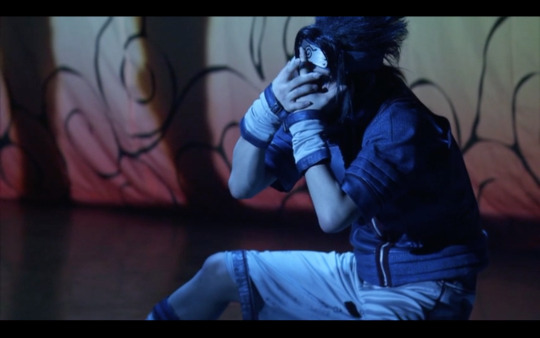
This is then repeated throughout Akatsuki no Shirabe. It starts even in the Opening to depict the relationship between Naruto and Sasuke.
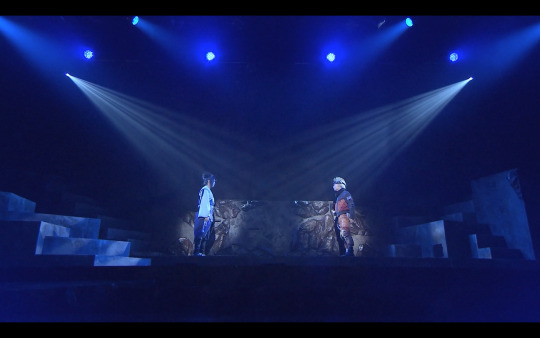
This is repeated in “Sagashidase”, where the piano comes in as Naruto and Sasuke sort of “speak” to each other (actually saying the lines from their fight at the Valley of the End).
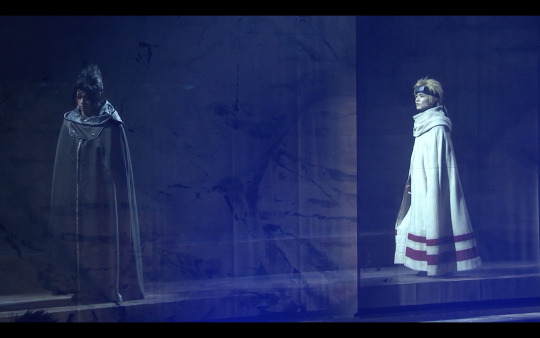
In “‘Akatsuki’ Mokuteki wa..!”, the song builds up gradually to Sasuke’s singing part, where it gives way to a soft piano sound.

The same motif happens in the song before the end of the first act “‘Wakare’ Mokuteki wa..!”, which, this time, begins with Sasuke’s part with a soft piano sound that later builds into a climactic ending.
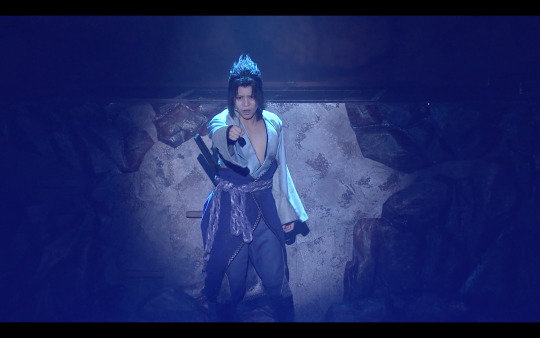
In “Naruto vs Orochimaru”, when Naruto thinks about Sasuke, prompting Sasuke to appear upstage, a piano melody interrupts the intense battle music, which then smashes back into the battle music once he vanishes.
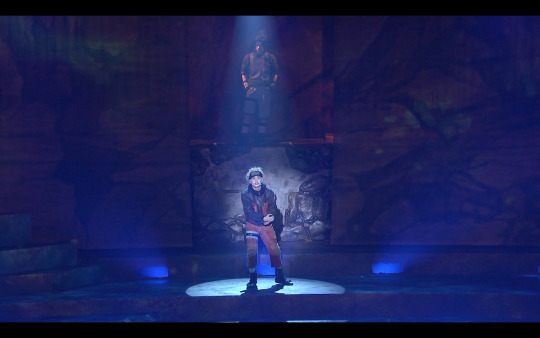
In “Kessei Shoutai ‘Hebi’”, when Suigetsu asks about Sasuke’s intentions for creating Hebi, the piano can again be heard interrupting as Sasuke mentions having a goal.
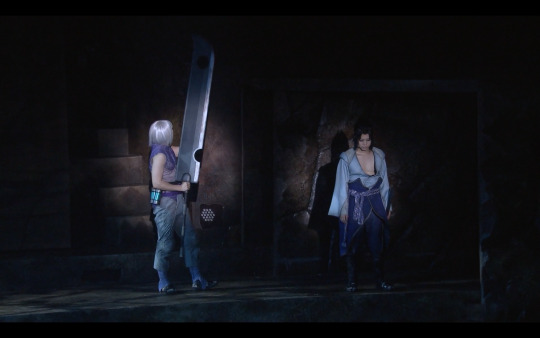
Even in “Tensei no Gishiki”, Sasuke taking over the control of Orochimaru’s jutsu is first indicated by a brief piano sound that interrupts the sound of strings.
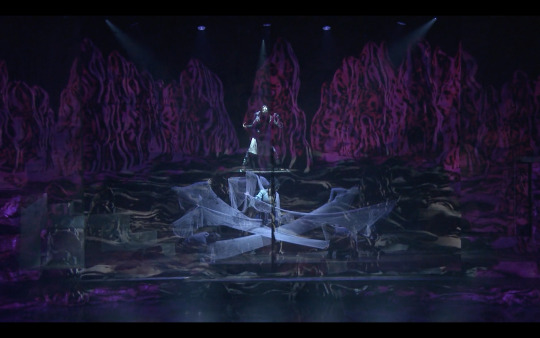
Finally, the piano is, of course, used in the duet (that made everyone cry), “Itachi no Shinjitsu”.
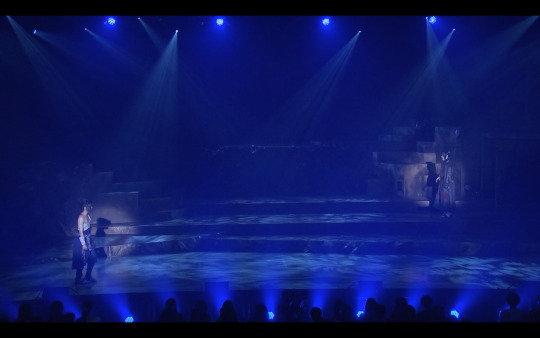
Okay, okay, you get it. Akatsuki no Shirabe associates Sasuke with a piano sound. But why? Why not stick to the usual twangy guitar sound that Sasuke has often been associated with?
I believe the answer lies in the angle that Akatsuki no Shirabe took on Sasuke, and on the story as a whole. Due to the constraints of being a time-limited-not-500-episode-long stage play, there needs to be a coherent flow in the events that lead to a final climax (and conclusion). Since the climax of Akatsuki no Shirabe is the fight between the Uchiha brothers, and the events leading up to it are depicted from Sasuke’s perspective, Akatsuki no Shirabe places Sasuke as the heart of the play, in a way, almost like he is the main character (even though Naruto is in the title of the performance. Sorry, Naruto.). In fact, Naruto’s character in this play is almost static, with no huge developments besides learning the Rasenshuriken, becoming even more motivated to save Sasuke, and learning to get along with Sai. The real character arc in the play belongs to Sasuke. Of course, this differs from in the anime, where the position of ‘hero’ is always centred on Naruto (obviously).
Because of Sasuke’s (almost) protagonist status in Akatsuki no Shirabe then, he becomes a more sympathetic character. Instead of emphasising on Sasuke as the cool, heartless, suave character foil to dorky Naruto, Sasuke’s vulnerability and softer side is emphasised on stage. Instead of putting Sasuke’s anger and hatred in the spotlight, it is his pain and grief that is highlighted.
The use of the piano enhances this image of Sasuke. Instead of the ‘cool’ sound of a guitar, it is replaced by the melancholic sound of a soft piano. The piano also brings out Sasuke’s ‘innocence’. This is contrasted against first Orochimaru, as his youthful body is what Orochimaru wants, and then Itachi, as Sasuke is the younger brother. Also, this innocence can be taken in the sense that Sasuke has been kept in the dark about the truth of the Uchiha massacre and is thus oblivious to it until the end, when it is revealed to him as a “plot twist” by Tobi.
Furthermore, the sound of the piano can be used to draw links between brother(ly) bonds. As previously mentioned, the piano is heard in the Opening during the moment between Naruto and Sasuke, as well as in “Sagashidase”, and it was also heard in “Naruto vs Orochimaru” with the brief appearance of pre-Shippuden Sasuke in Naruto’s memory. This associates that piano melody with the bond between Naruto and Sasuke, which is often compared to a brotherly bond.
In fact, the use of the piano as highlighting brotherly bonds is further enhanced by Sai’s arc in the play, as during “Ninmu ~ Niisan no Kioku”, when Sai is reminded of his older brother, the piano is played. When contextualised in the context of the structure of the play, Sai’s arc in Act 1 is positioned almost like a prologue to the relationship between the brothers that are at the heart of the play, the Uchiha brothers, leading into Act 2’s confrontation between the Uchiha brothers. (It���s different in the anime where Sai’s arc is just, well, his arc.)
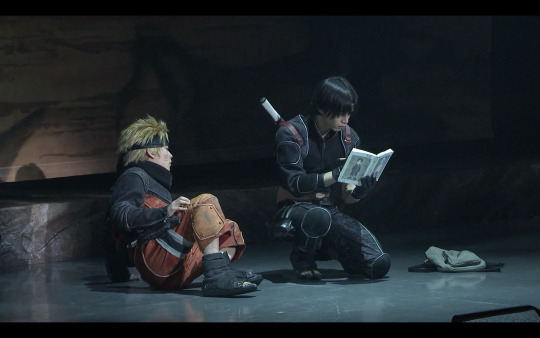
This connection with brotherly bonds is later emphasised again through the piano melody in the song “Mangekyo Sharingan”, where Itachi tells the story of Madara and Izuna, meant to mirror the ‘cursed’ relationship of the Uchiha brothers. It serves to highlight the burden of the blood bonds within the Uchiha clans and the ‘curse’ that comes with it, pitting brother against brother for power.
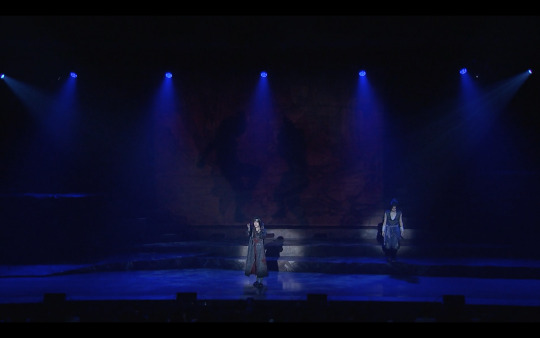
The piano therefore takes on an association with the brotherly bonds that are the centre of this play. Sasuke’s affiliation with the piano serves to highlight that his fate and destiny has been decided in his position as the younger brother. As Rachi Shinji put it, Sasuke is bound by his blood ties and constantly feels the burden of the responsibility that his blood and his clan has put on him. His own sense of self has been tied to his role as the avenger of his clan and has pushed him to extreme ends to fulfil his duty.
From this angle, Sasuke becomes a more sympathetic character – we see how his identity has become entangled in the responsibility of being the survivor of his clan, and how this has weighed on him and shaped his destiny and his decisions. His anguish upon realising that everything that he had based his identity on is false becomes much more striking. This isn’t a departure from the Sasuke in the anime and manga, but instead, Sasuke’s pain at the final revelation becomes more palpable, and this makes his declaration to destroy Konoha for what it did more believable and even understandable.
Of course, the music direction was only one of the elements that brought this aspect of Sasuke out so strongly, but it is a display of how powerful a simple change can be in the shaping of a character. For a character as complex as Uchiha Sasuke, it was certainly a welcome take on his story.
65 notes
·
View notes
Text
The Best Naruto Shippuden Fight Doesn't Include Naruto
If you’ve ended up watching enough Naruto, you’ll begin to pick up on the overall style of the show. The way the characters look, how they animate, the specific colors used throughout the series, there’s a certain way that Naruto and Naruto Shippuden look through their combined first 300 episodes. On rare occasions, that style switches to help showcase a big fight, such as early on against Zabuza and Haku, Rock Lee vs. Gaara, and in Shippuden when the Leaf takes on Hidan and Kakuzu, Sasuke vs. Deidara, and others further in the series. This fluid animation style alters how the characters look and move, while also using more of a muted color scheme. Most notably, this is usually thanks in part to episodes that Hirofumi Suzuki worked on as the animation director.
One episode that Suzuki worked on that sticks out by subverting the regular formula of Naruto is Episode 82 of Shippuden, "Team Ten." It’s not an episode that features any big fights, nor are there really any big conflicts between characters here. Instead, we see the inner turmoil that Shikamaru is facing following the death of Asuma. He’s skipping out on his funeral and just seems lost after the previous mission went horribly wrong. So, instead of creating another episode of Shippuden that is the same formula as everything else, Suzuki and the rest of the production staff decided to go in a different direction — one that is more likely to be seen on the big screen, rather than in television.
Given the highly emotional aspects of where the story is, the episode does a lot to make you feel uncomfortable — to get you into the same headspace as Shikamaru — and at times almost makes the viewer seem like a voyeur. We’re essentially going through the same process as Shikamaru as we see him tell Kurenai about Asuma’s death, relay that to people in town, figure out his own emotions about what happened, and then come back from the brink and find a way to stand tall again.
In order to truly get into Shikamaru’s mindset for this episode, the pacing slows to a halt. Everything is laborious and with a certain purpose to it. This is the kind of pacing and style you’d most likely see from a Naruto film or a more serious drama series rather than what you’d expect from a shonen series. It would be hard to pull off what this episode wants to force the viewer to witness if it was the same package that every other episode of Naruto Shippuden is. In order to pull viewers in and let them immediately know that something is wrong, you’ve got to disrupt their normalcy and their perception of what the series is.
Throughout the episode, if you’re watching for the first time or just trying to pay attention to figure out what’s different, you’ll notice a few things. Most notable to me was the lack of camera movement. Shonen series and anything with action will rely on camera movement to make episodes have a fast pace to them. Instead, here we get only four shots that feature any sort of movement. Each one is incredibly slight as well. They’re not quick but are slow and subtle to where you can easily miss them. In fact, the first bit of camera movement doesn’t occur until nearly halfway through the episode, which seems striking for this series. Instead, we get a lot of cuts and shots that linger long enough that it begins to feel uncomfortable.
One of the more striking shots in this episode is when Shikamaru and his father, Shikaku, play shogi together. There are cuts between the two as they begin to play, but then the camera goes to a side angle of the two playing and going back and forth with their moves. You’d think that eventually there would be cuts to each character as they place their moves and with Shikaku trying to tell Shikamaru why he shouldn’t beat himself up over what happened. Instead, the shot lingers. For two whole minutes. That’s not something that occurs in most series that are relegated to 24 minutes of air time. After all, camera cuts help keep the pace up and give viewers something new to look at. Yet, it fits the overall tone and style of this episode. You start to see Shikamaru’s emotions begin to get the better of him from this shot alone, and it’s able to tell that story in a better way than it would have if it was just the camera cutting between Shikamaru and Shikaku.
That scene, and those two minutes spent looking at their shogi game, leads up to Shikamaru finally being able to break down. This brings up another strange aspect of this episode: This scene is the first time we hear any music in the episode and again, we’re nearly halfway through. Before, you’d hear a lot of natural sounds such as insects humming or the chatter of people in the streets as Shikamaru wanders through the town. Even with the addition of music for this brief instant, it’s again subtle and not overpowering. It’s another aspect of something that you could easily gloss over as it comes and goes very quickly. That might seem as if it doesn’t really fit the emotional nature of this scene given that Shikamaru begins to cry and wail in this room they were playing in, but it absolutely fits because the music is just giving the viewer the slight push to tell them this is emotional. That doesn’t need to overpower the scene when you’ve got a character letting out deep emotional pain at the same time.
Perhaps this is why Suzuki and the rest of the production staff were tapped for this episode. Their style of animation that has worked so well for some of the biggest fights in the series works its magic for truly showing the emotional pain a character is going through. You’re able to see the pain and trauma rise up through Shikamaru’s face and then break through the levy as he’s finally able to let out all of his emotions and cry. His face distorts in realistic ways that wouldn’t have been the same if it was in the traditional animation or style. It’s the same kind of realistic expression that you would also have if you were in his situation, which of course is what the episode is trying to make you do. Become emotional and cry alongside Shikamaru.
One of the biggest takeaways I had from this episode is how much Suzuki and the team’s style reminded me of Naoko Yamada’s way of directing. Yamada’s work on K-ON and specifically Liz and the Blue Bird are very similar to what we see in this episode. There’s a lot of lingering shots, little camera movement, and relying more on cuts to showcase what’s happening — and a soundtrack that isn’t overemphasizing what’s happening. You truly get to see what these characters go through, which is an aspect of directing that Yamada accentuates as she’s said she likes to “watch people” and “get into the minds of the characters.” Those are definitely part of what makes this episode of Naruto Shippuden work so well. You’re truly able to dive into Shikamaru and see what he’s going through, how he’s able to figure out what to do next, and then act upon it.
The rest of the episode sees how Shikamaru is able to find an answer that gives him the drive to go out and finish the original mission and avenge Asuma. The pacing is still slow and methodical, but by the time we reach the end and Team Ten announces their plans to head out on their next mission while Tsunade tries to stop them, we begin to move back into the regular style of Shippuden as the music begins to take hold in a way you’d normally expect. In a way, this episode is able to pump the brakes on the whole pacing of the show, but then softly begins to accelerate by the end that lets you ease back into what you’d expect from the series.
There’s truly no way you could do this kind of episode for a series as big as Naruto every week. Obviously it’d take too long to maintain this kind of quality for 500 episodes, so you’d have an episode a month at best, but also the charm of these subversions to the series would wear off rather quickly. Instead, you’d have fast-paced, action-packed episodes that would serve as that. “Team Ten” is a special episode and one that rewards people for sticking with the series as it lets you truly see everything from a different perspective, from pacing, style, character development, to storytelling. It’s hard to argue that this isn’t one of the absolute best parts of the series and should be recognized in the same way that the best fights of the series are.
What are some of your favorite episodes that seem to try and shake up the status quo of Naruto? Let us know down in the comments below!
Jared Clemons is a writer and podcaster for Seasonal Anime Checkup where he can be found always wanting to talk about Love Live! Sunshine!! or whatever else he's into at the moment. He can be found on Twitter @ragbag.
Do you love writing? Do you love anime? If you have an idea for a features story, pitch it to Crunchyroll Features!
0 notes
Text
Does Boruto’s Time Skip Arc Fit the Tone of the Original Naruto Anime?
Over the course of 2/3rds of this year, some of us on the Crunchyroll Features team embarked on an incredible journey known as THE GREAT CRUNCHYROLL NARUTO REWATCH. We went through all 220 episodes of Naruto and got to see everything from incredible fights to a whole lot of filler. For someone like me, it was a fun way to watch a series I completely missed out on since by the time I stopped watching anime around 2003, Naruto really hadn’t become the popular juggernaut it’d eventually become.
Since the Rewatch, the creators of BORUTO: NARUTO NEXT GENERATIONS clearly were reading along and thought, we should totally do something that fits into this very specific feature. This new time skip arc of Boruto was intriguing to me as someone who’s only watched Naruto and not ventured past that, especially with the idea if they can recapture the style, feel, and storytelling of a series that had its last episode over ten years ago. So, with Naruto still fresh in my mind, is this new arc going to be reminiscent of the main story or more in line with a filler arc?
Coming to Boruto with very little knowledge of what’s happened in the series and everything else that transpired in Shippuden, it’s a bit intimidating to dive in considering I’m missing over 600 episodes of content. Boruto actually seems to understand that there might be people like me coming to this arc who aren’t following along with the current product. You get a good mix of seeing folks you’d remember who are now older. That included me exclaiming, “Choji, you look old!” Plus, you get a good introduction to Boruto and how he is as a character before we get to time warping.
There are some odd things for newcomers such as Naruto being cold to Boruto and Sasuke no longer being the poster child for Hot Topic, but it’s nothing that is confusing in any sort of way. Boruto also does a decent job of showing off its villain for this arc and explaining their motivations and powers pretty quickly, despite them clearly being around previously. Once Sasuke and Boruto find themselves back in the Hidden Leaf Village of the past, that’s where the show really showcases that it knows what it’s doing. Since that happens at the end of an episode, Boruto immediately lets you, the viewers, know you’re going back to the past by switching to the classic Naruto next episode music.
The changing of music continues throughout the rest of the arc as now all of the backing tracks are ones you’d constantly hear in Naruto. It’s such a smart decision that they could have not made and instead stuck with the Boruto soundtrack. Hearing those older tracks gives you a nice warm feeling, and it’s legitimately true nostalgia—which is weird for me to say since I’ve only just watched Naruto, but it still works all the same. It’s as if you’ve unearthed this unseen Naruto arc that never aired during its initial run from 2002-2007. If you weren’t paying attention to the screen and were just listening, you’d think this was actually Naruto.
The artstyle doesn’t really change from how Boruto has seemed to look previously, yet the younger versions of Naruto, Sakura, and everyone else looks the same as you’d remember them. Their designs fit in with the style that Boruto uses and doesn’t hinder or hurt these older characters in any sort of way. The only knocks I’d have against it is that the animation doesn’t seem to be as experimental or wild as Naruto could be at times, although there haven’t been any big fights for it to really do that. Also, I kind of with they’d switched from 16:9 to 4:3 for when they’re in the past, but I get that’d probably be a tough switch considering everybody involved in production is so used to creating shows at that aspect ratio now.
Now, let’s talk about this arc’s story since that’s the crux of the whole thing. The abilities of Urashiki that they described certainly make this whole story possible in a way that’s believable, and it’s placed just before the Sasuke Retrieval Arc to ensure Sasuke doesn’t run into himself. Sasuke basically putting the rules of Back to the Future in effect so Boruto doesn’t mess up the future is funny, and there’s even a moment where you get worried the show might take one of the plot points of that film series. The writing seems pretty good throughout as well, but then you have to see aspects like Sexy Jutsu again which is still groan inducing. If you put kid Naruto into something, that’s gotta show up apparently. We can only hope this arc doesn’t end with a fart joke or with some of the bad ways Naruto would try to implement humor.
All of the other trios show up as well which gives you a good chance to remember how these characters were as kids. Obviously this arc hasn’t completed yet, but if we don’t get some ridiculous Boruto versus Rock Lee encounter, I’ll be very disappointed. It would have been easy to just make this an easy nostalgia cash in arc, but the writing thus far has captured what made those early Naruto arcs so fun. The determination of Naruto, his ability to try his best despite being racked with the guilt of Sasuke leaving, and allowing Boruto to see this new side of his dad that it seems he’s never witnessed before. Despite this arc not having Naruto as the person leading it, he’s still a big proponent that it keeps the soul of the original Naruto and gives you new character moments with someone who’s been well developed for almost twenty years in anime.
Through six episodes, this doesn’t really have the same feeling that even the best filler arcs of Naruto had. This is certainly much more in line with the adapted source material, since we’re not meeting characters and having them immediately not mean anything. Although, this actually has the same problem that Naruto filler had in that we know that Naruto can’t have anything bad happen to him. Unless Boruto is going to go off in a completely shocking direction, he’s not going to die, get gravely injured, or get any affliction that affects his future self. If that does end up happening, you’d presume to think it’d get solved in some sort of way. Even with that caveat, it really doesn’t take away from what this arc has shown thus far.
This Boruto time skip arc made me realize how much I’d missed young Naruto’s adventures with his pals and all the shenanigans he’d get into. It’s fun to see him be a little turd at times, but still have that heart of gold that makes his story so appealable. I went into this thinking that Boruto might make this a bit tough to follow, but it’d be at least fun, and it’s exceeded my expectations. I am very excited to see where this arc goes. For those of you that only have vague memories of Naruto and didn’t go further, haven’t really dived into Boruto, or just want to see the younger versions of these classic characters, it’s safe to say that Boruto has done a great job of recapturing what made the original Naruto a fun ride.
Where are you expecting this time skip arc to eventually lead to? What kind of shenanigans can Boruto and Sasuke get up to with Naruto, Jiraiya, and everyone else? Has this led you to feeling nostalgia for Naruto? Let us kow down in the comments below!
---
Jared Clemons is a writer and podcaster for Seasonal Anime Checkup where he can be found always wanting to talk about Love Live! Sunshine!! or whatever else he's into at the moment. He can be found on Twitter @ragbag.
Do you love writing? Do you love anime? If you have an idea for a features story, pitch it to Crunchyroll Features!
0 notes